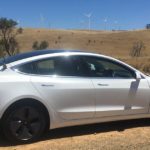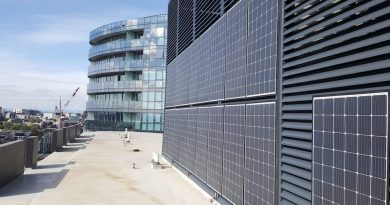Electric Cars Vs Petrol Cars: How Much Can You Save?
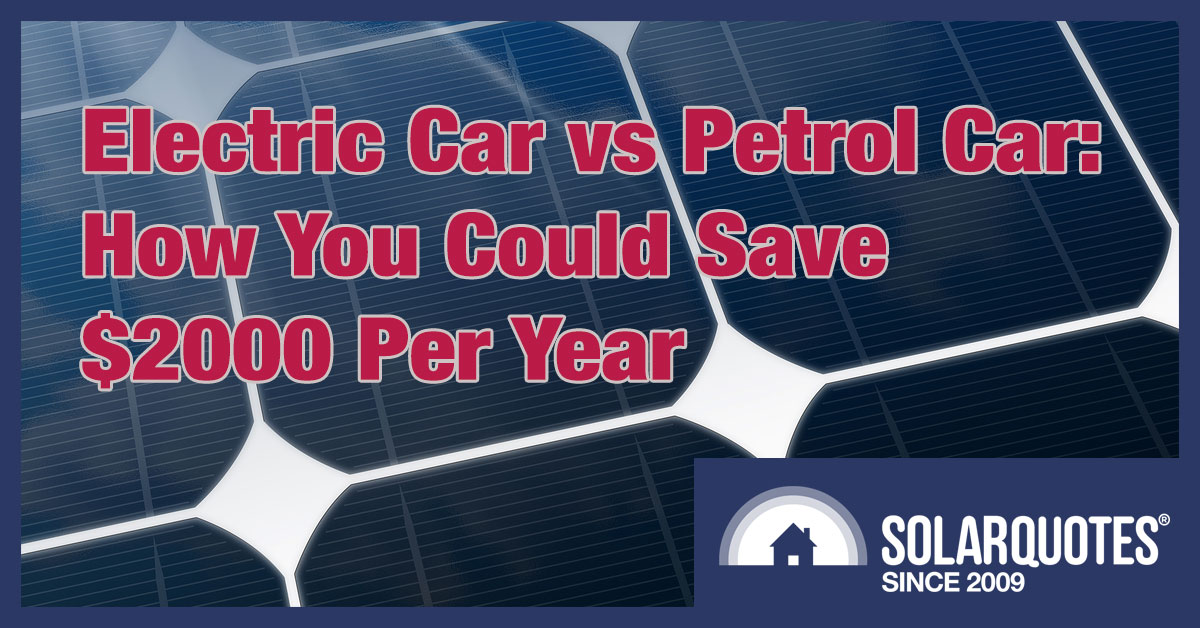

The next new car you buy should be electric.
I’m serious about this. I’m willing to include fuel-efficient hybrids in my advice for now, but anyone who’s not in the habit of chucking laps around the Strzelecki Desert should consider an all-electric car next time they’re looking to buy a new vehicle or a pricey second hand one.
There’s a sound financial reason why and that’s the low running costs of EVs (Electric Vehicles).
The fact electric cars are cheap to run isn’t news. It’s easy to find articles on the internet saying this. But a plentiful portion of the population remains unaware of how large the savings can be, especially when the EV is at least partially charged by a rooftop solar power system.
So I’ve decided to throw my hat in the ring and give my own estimate. (My hat is easy to recognize. It’s made of chocolate in case I have to eat it.) Even I was impressed by what I found. Over 10 years, the savings on fuel and servicing — compared to running the average Australian passenger car with $1.50 a litre petrol — comes to around $20,000.
Resale Price Of Conventional Cars Will Plummet
If you buy a conventional car instead, not only will you miss out on these savings, I’m certain your vehicle’s value will soon plummet as EVs destroy demand for internal combustion engine (ICE) vehicles.
Second-hand cars currently command high prices thanks to the pandemic, but the next few months may be your last chance to unload a petrol or diesel-powered car at a good price. We’ve seen Tesla electric cars drive down the resale value of luxury cars they were competing with over the past few years. Now the Tesla Model 3 has fallen in price and more affordable electric cars are becoming available, we’ll see the same happen with mid-range and lower cost conventional cars.
Australians already recognize the advantages of EVs. This CarsGuide article says the Tesla Model 3 may outsell Toyota Camry this year. I’m tempted to buy a Tesla Model 3 myself. The only thing holding me back is — if I buy a nice car, I’ll need a nice place to keep it and next thing you know, I’ll have spent over $200 renovating my home1.
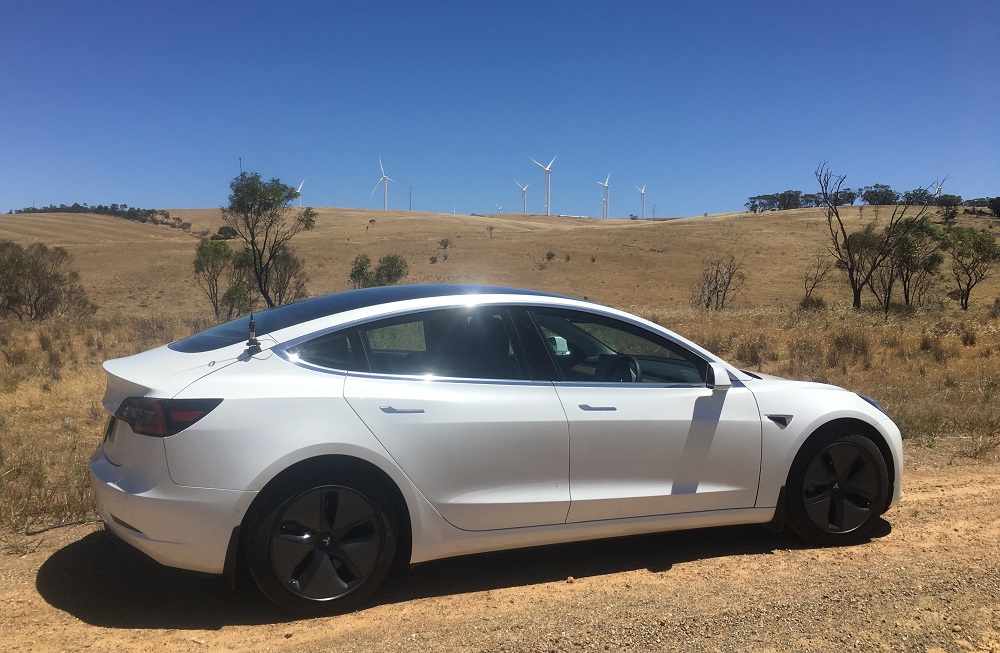
A Tesla Model 3 with some Snowtown wind turbines in the background.
The Electric Vehicle Council Calculator
I was going to refer you all to the Electric Vehicle Council EV Cost Calculator. It’s good for estimating the running costs of EVs versus conventional cars across Australia under various conditions. But it had better be good, as we all paid for it through the Australian Renewable Energy Agency.
Unfortunately, it’s been down all weekend, so I can’t tell you how close its figures come to my own2. But from what I can remember, back in the days when it worked — Friday was one of them — it was pretty good.
Making My Own Estimate
I will estimate how much it costs to charge and service an EV driven 12,600 km per year. This is the average for Australian passenger cars in the 2017/18 financial year. I chose the year so the result won’t be affected by the pandemic3. I’ll compare it to costs for the average Australian petrol-powered passenger car driven the same distance.
To do this, I’ll need figures for…
- The cost of electricity — both from the grid and rooftop solar panels.
- The range an EV gains when charged with 1 kilowatt-hour of electricity.
- Annual servicing costs.
I’m going to assume the cost of replacing tyres is the same for both types of vehicles and ignore that expense. I’ll also assume they don’t smack into anything and not account for crash repairs. Another assumption is they won’t break down out of warranty and leave the owner out of pocket for repairs. Because very little can go wrong with an electric car, this is a reasonable assumption.
EV Subsidies & Road Taxes
At the State and Territory level, various subsidies have been introduced for EVs:
- NSW: $3,000 off 25,000 EVs with a purchase price of $68,750 or less plus no stamp duty for EVs up to $78,000 for a maximum reduction of $5,540 in total.
- SA: $3,000 off the purchase price for 7,000 EVs with a purchase price of $68,740 or less.
- VIC: $3,000 off purchase price for over 20,000 EVs up to $68,740 or less.
Counter-productively, these three states have also put taxes on EVs that will — to start with — be used to pay for subsidies on EVs. This is very stupid. It’s not even robbing Peter to pay Paul. It’s robbing Peter to pay Peter while charging Peter for the administration costs of robbing her4.
The tax will be a per km charge for full EVs and plug-in hybrids:
- Plug-in hybrid: 2 cents per km
- Full electric vehicle: 2.5 cents per km.
Fortunately, SA and NSW are unlikely to introduce their tax for several years, but you already have to shell out in Victoria if you have an electric vehicle.
You may get some consolation from the fact if you buy an EV now, a $3,000 subsidy will cover the cost of a full EV’s road tax for 9.5 years if driven the average distance for a passenger car. Because many who buy new cars don’t keep them that long, the road tax for your first EV purchase will be more than covered for most — provided you don’t wait too long and miss out on the subsidy.
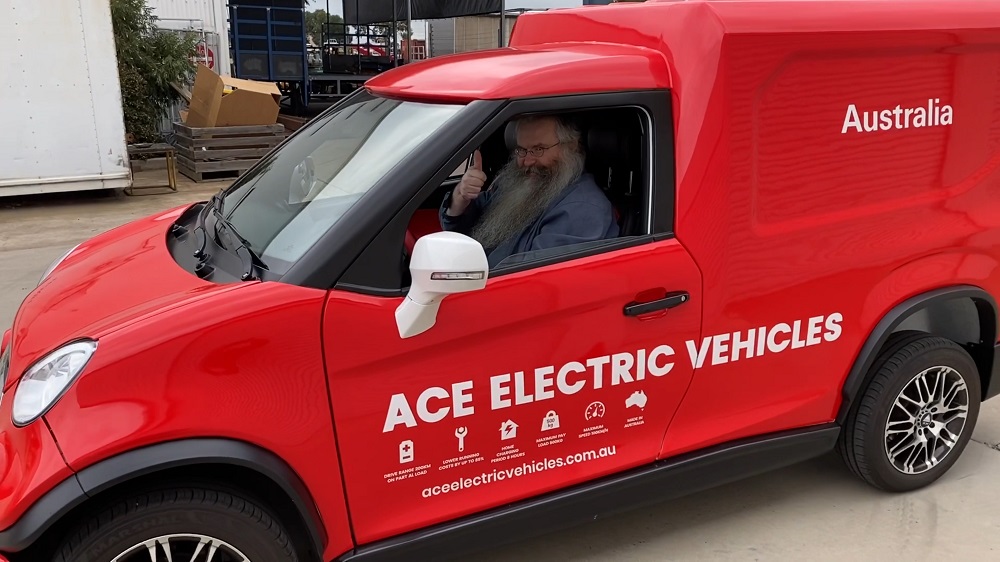
EVen Australian made EVs will have to pay the tax.
Electricity Costs
Electricity costs aren’t difficult to find. The SolarQuotes Electricity Retailer Comparison page shows what’s on offer across Australia. Plans with the following grid electricity charges and solar feed-in tariffs in cents per kilowatt-hour are currently available:
- Adelaide: Grid 32 cents, Solar feed-in 12 cents
- Brisbane: Grid 19 cents, Solar feed-in 11 cents
- Canberra: Grid 25 cents, Solar feed-in 10 cents
- Darwin: Grid 29 cents, Solar feed-in 8 cents
- Hobart: Grid 25 cents, Solar feed-in 10 cents
- Melbourne: Grid 20 cents, Solar feed-in 10 cents
- Perth: Grid 29 cents, Solar feed-in 4 cents
- Sydney: Grid 24 cents, Solar feed-in 12 cents
To keep things manageable, I’m only considering flat tariffs, but if you have a time-of-use tariff and take care to mostly only charge during off-peak periods, the cost of grid electricity can be considerably less. You may also be able to find special offers for EV charging.
If you don’t have solar, you may be able to find a flat tariff plan with slightly lower grid electricity charges than these, but I’m only looking at plans that are good for homes with solar power systems.
Range Per Kilowatt-Hour
When I drove a Tesla Model 3 I averaged 1 km of driving for every 0.145 kilowatt-hours of energy drained from the battery pack. This gives an average of 6.9 kilometres per kilowatt-hour. But a home EV charger is only around 85-88% efficient5. So, assuming the charger I used was 88% efficient, that’s 6 km of range for every kilowatt-hour of electricity used to charge the EV.
Tesla Model 3 owners have told me they use less energy per km on average than I did. There are also more energy-efficient electric cars such as the Hyundai Ioniq, which appears to manage 7.1 km per kilowatt-hour around town if 88% efficient charging is used. So a figure of 6 km of range per kilowatt-hour used to charge the car is reasonable, even if the average charging efficiency is worse than 88%. The Tesla Model 3 is also high performance with plenty of interior and cargo space, so it’s fair to compare it to a petrol-powered passenger car with average fuel efficiency.
Petrol Cost Per KM
The average Australian passenger car consumes 11.1 litres of petrol per 100 km. That comes to a lousy 9 km per litre. Australian vehicle fuel efficiency is now worse than in the United States and has been for years. This is because the US has vehicle fuel efficiency standards, and we don’t.
This is a clear example of how our Federal Government is dumber than a sack full of hammers used for hot air balloon ballast. The US imports around 24% of its oil and have fuel efficiency standards, while Australia imports 87% and has none.
Petrol is $1.66 at the moment, but I’m going to assume it will average $1.50 per litre. This will make the fuel cost per km 16.7 cents.
As electric cars increase in number, the demand for oil will decrease, and this has the potential to push down the oil price and make conventional cars cheaper to run. But, on the other hand, fossil fuels may be hit with carbon and pollution charges that push up their prices.
Cost Of Grid Charging
If an EV gains 6 km of range from 1 kilowatt-hour of electricity, the energy cost per km will be its cost divided by 6. If grid electricity is used at 24 cents per kilowatt-hour, the energy cost will be 4 cents per km. That’s less than one-quarter of the 16.7 cents per km cost of petrol.
On average, an EV will consume 5.8 kilowatt-hours per day. These days only four solar panels can provide that per average day. But, in practice, you’ll want a lot more than that. Especially if you get two electric cars.
Grid+Solar Charging
If energy from rooftop solar panels is used to charge an EV, the cost per km is even lower6. As the household won’t receive the solar feed-in tariff they would if the energy had been sent into the grid, charging with 1 kilowatt-hour from solar energy effectively costs the solar feed-in tariff.
Provided they haven’t installed undersized solar systems, many households will be able to charge their EVs with 50% or more solar energy. This is because plenty of cars are parked at home during the day for long enough to make this possible.
Some appear to think almost every car is driven to work or a train station in the morning and left there all day, making it unavailable for home solar charging. While this is true on weekdays for many passenger cars, it was only 50% before the pandemic and will be less now working at home is more common.
The graph below shows the energy cost per km for the average Australian petrol-powered car compared to an EV in each capital. The costs in cents per km for EVs are in dark green for charged 100% from the grid, and light green for 50% grid charged and 50% charged by rooftop solar power:
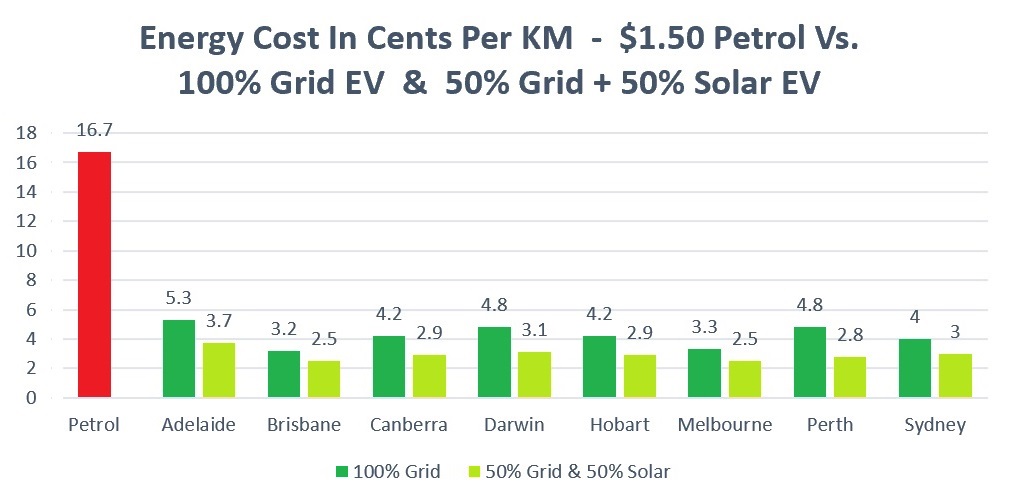

As you can see, even in the most expensive cases — 100% grid charging in Darwin and Perth — the cost of using petrol is three and a half times higher. In the lowest cost situations — 50% grid + 50% solar charging in Brisbane and Melbourne — the cost of petrol is over six and a half times higher.
90% Solar Charging
People with EVs that are often parked at home during the day will have the opportunity to charge them with up to 100% rooftop solar energy provided they have a smart charger or another method to ensure they are almost exclusively provided with solar energy.
While most people won’t manage 100%, as there will be times when they go on long trips and charge away from home, 90% solar power is definitely achievable. In this case, the cost per kilometre in the different capitals will be:
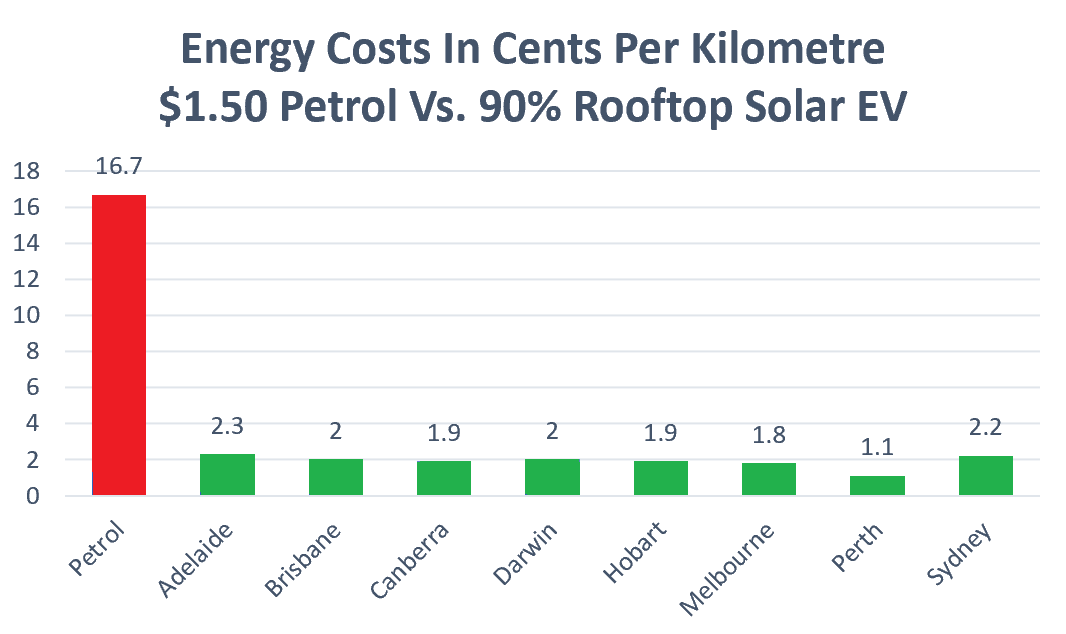

Charging with 90% rooftop solar power is cheap no matter where you are and cheapest in Perth, where petrol costs 15 times more per km. This is due to WA’s low feed-in tariff for new solar installations. It averages around 4 cents through the day but is only 3 cents per kilowatt-hour before 3:00 pm, so if EV charging is done before then, it will only be around 0.9 cents per km.
Cost Of Servicing
There’s a lot of variation in what people pay for car servicing. My parents pay a few hundred dollars a year, while some regularly fork out over $800 for a single 10,000 km service. I will assume a reasonably frugal, but not rock bottom annual cost of $400 for conventional car servicing. This includes the replacement of parts with limited lifespans, such as mufflers.
The cost of maintenance for electric cars is far less. Or at least it definitely should be. Currently, electric car manufacturers seem torn between using low service costs as a selling point and bilking customers out of as much money as they can. Finn’s Tesla Model S has done 32,000 km, and he has paid nothing for servicing so far.
I’m going to allow $100 a year for EV servicing. This should be an overestimate, as very little needs to be done with electric cars. If you know how to refill the wiper reservoir and check the brake fluid, you should be right for a very long time.
Annual Cost Petrol Vs. EV
At $1.50 per litre, the cost of driving the average Australian passenger car 12,600 km over a year comes to $2,100. Adding $400 for servicing brings the total to $2,500. The graph below shows how this compares to EVs in capital cities with those 100% charged from the grid in dark green and 50% grid + 50% rooftop solar charged in light green:
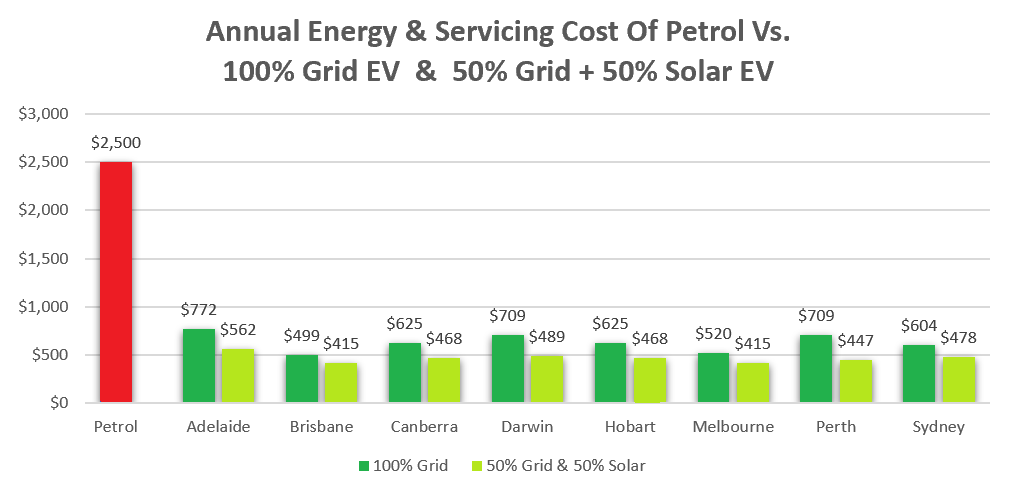

Don’t Worry If You Can’t Charge With 100% Solar
With the electricity plan examples I used, the lowest savings from charging with 50% rooftop solar compared to 100% grid are in Brisbane and come to $84 a year. Not a huge amount, but still worthwhile. The greatest savings from 50% rooftop solar charging are in Perth and come to an appreciable $262 a year. That’s around $2,600 over a decade.
Annual EV Savings
The graph below shows how much you’ll save per year on energy and service costs by driving an EV. The dark green columns show savings when charging 100% and light green columns show savings from charging 50% from the grid and 50% from rooftop solar power:
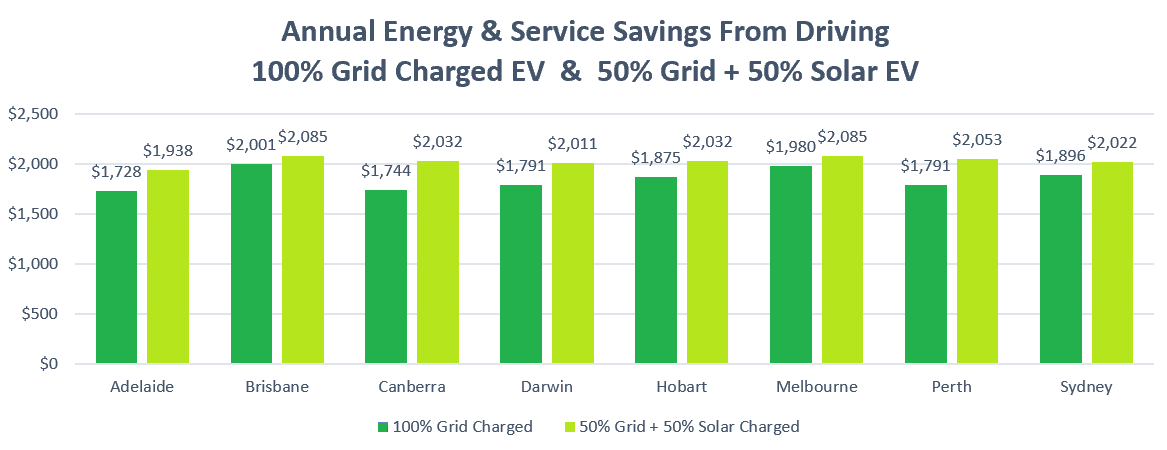

For EVs 50% charged by rooftop solar, the savings come to over $2,000 per year in every capital except Adelaide.
If you are in Victoria, the EV tax will reduce the savings by $315 a year, but at least that’s a lot less than the $3,000 subsidy available for new EVs in the state.
Annual EV Cost With 90% Solar Charging
To really rub in how cheap running an EV off solar power is, I made the graph below comparing annual energy and service costs for the average petrol passenger car versus an EV 90% charged with rooftop solar panels:
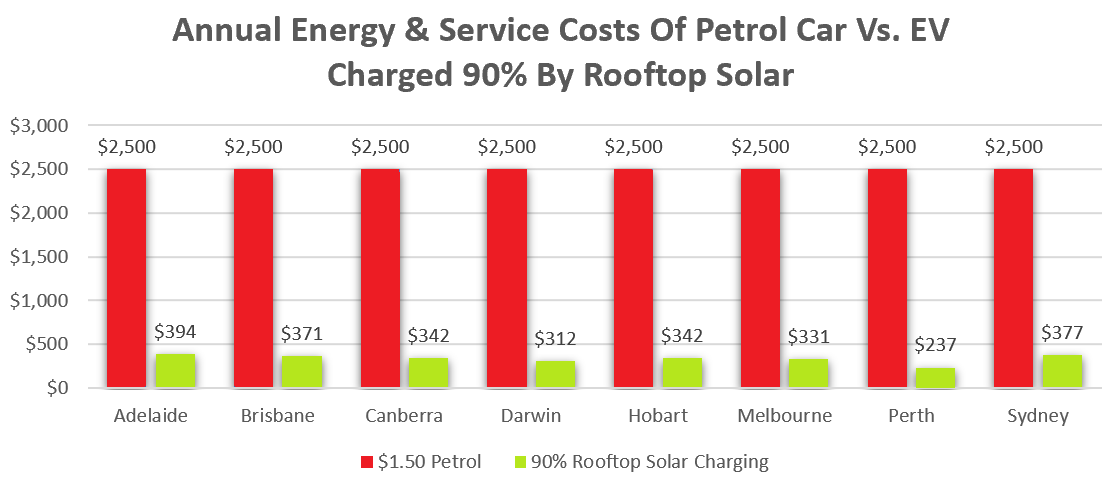

When an EV is mostly charged with rooftop solar, its annual running costs are typically less than one-seventh those of the average petrol-powered car. In Perth, thanks to their low solar feed-in tariff, it’s under one-tenth.
Drive 25,000 KM A Year? Double The Savings
The savings above are for EVs driven the national annual average for passenger cars of 12,600 km. If you drive 25,200 km a year, savings double to around $40,000 over 10 years. Clearly, an EV is a no brainer for anyone who racks up a lot of kilometres — with a possible exception if they’re racked up driving long distances through the outback. In that case, you should consider buying a hybrid. Or possibly a long-range Tesla.
Comparison With A Small Petrol Car
The average Australian petrol passenger car only gets 9 km per litre. But if you’re considering buying a small electric car, you may think the appropriate comparison is a small petrol-powered car with higher fuel efficiency. If the service cost of $400 a year is left the same, the annual running costs of petrol-powered cars with varying fuel efficiencies will be:
- 9 km per litre (11.1 litres per 100 km) — $2,500
- 10 km per litre (10 litres per 100 km) — $2,290
- 15 km per litre (7.5 litres per 100 km) — $1,660
- 20 km per litre (5 litres per 100 km) — $1,450
Even for a petrol-powered car getting 20 km per litre, which is extremely good if it isn’t a hybrid, the total of its energy and service costs will be double that of an EV that gets 6 km of range per kilowatt-hour. But note a small EV is likely to be more energy-efficient and have moderately lower running costs.
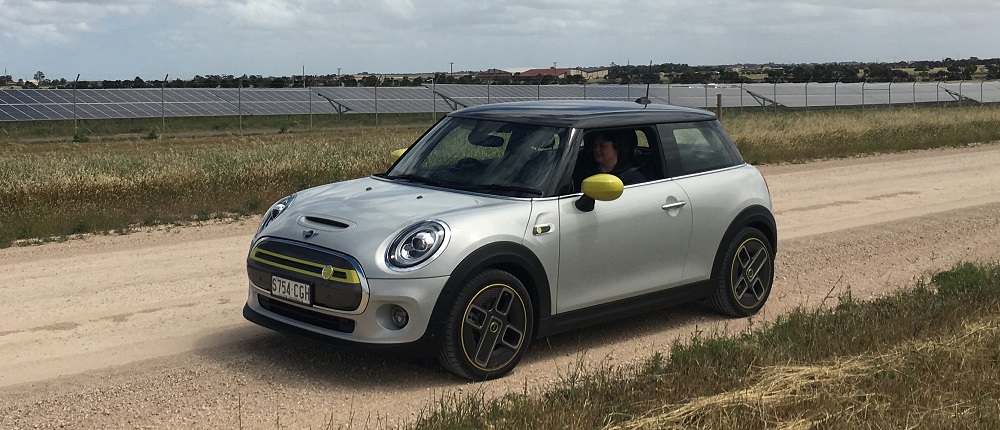
The Electric Mini isn’t large, but when I drove this one I got less range per kilowatt-hour than I did in a Tesla Model 3.
Overlooked EV Costs
There are some expenses involved with EVs that are sometimes overlooked. These include:
- A home charger
- A charging cable
- Potentially higher insurance and repair costs
- Battery replacement
Home Charger:
An EV can be charged from a regular, 10A powerpoint, but I recommend getting a home charger. It’s faster, more efficient, and a smart one will let you maximize your solar self-consumption by giving the option of only charging when your rooftop solar power system is supplying surplus energy. Having one of these installed may set you back around $1,500. If you have 3 phase power, I recommend paying a few hundred more for a 3 phase charger. This will allow faster charging if you’re in a rush.
Charging Cable:
Some public EV chargers require you to bring your own heavy-duty charging cable.
Higher Insurance & Repair Costs:
EVs generally don’t have higher insurance costs than conventional cars, but if you’re willing to spend more to get an EV to take advantage of its lower running costs, your insurance premiums will reflect having a more expensive car.
I have heard of EV owners being charged ridiculous amounts for repairs, but I’ve heard the same for conventional cars, so I’m not entirely sure there is a large difference here. But as EVs are fairly new in Australia, this could raise repair costs for those who usually get their spare parts from a wrecker.
Battery Replacement Costs:
Most EVs have battery warranties that last 7 or 8 years with normal use, and I think few people will want to replace theirs before 10 or more years have passed. I expect many EVs will keep their original battery packs for 15 years7, but we’ll have to wait and see how that turns out.
So far, none of the people I’ve talked to who are interested in buying a new electric car are much worried about the cost of replacing the battery pack.
At the moment, the price of EV battery packs is around $140 per kilowatt-hour. I wouldn’t be surprised if in 10 years electric car manufacturers couldn’t source them for half that amount.
At $70 per kilowatt-hour, a 50 kilowatt-hour battery pack would cost $3,500. Whether or not you’d be able to buy a compatible one and have it installed for that much is another question. But if the manufacturer of your EV wants to charge an outrageous price for a battery pack replacement, in Australia, I expect you’ll be able to get a third party battery installed at a reasonable price.
Potential Additional EV Savings
I’ve mentioned some EV expenses that are sometimes overlooked, but they also have potential financial benefits that include…
- EV electricity plans allowing grid charging at greatly reduced cost when wholesale electricity prices are low.
- Payments for EVs supporting the grid by providing power when it’s in high demand.
- Far lower wear and tear than internal combustion engine vehicles.
Grid Electricity Prices For EVs May Fall:
As the amount of renewable energy generation increases, periods where wholesale electricity prices are either low or around zero will increase. This means electricity retailers are likely to offer plans or options for people with EVs that allow them to charge cheaply at these times. There may already be offers available for EVs in your area.
Increasing renewable energy generation also means the long term trend is for both wholesale electricity prices and solar feed-in tariffs to fall. This will take time as we still have a lot of coal capacity to close down, but in the future self-consuming your solar electricity by using it to charge your car is likely to be an even better idea than it is now.
Vehicle To Grid Payments (V2G):
EVs can be paid for supplying energy to the grid when wholesale electricity prices are high. This is only possible when the EV is plugged in, but most cars spend most of their time parked at home, so there’s plenty of potential to make money this way.
But while V2G is being trialled in Australia, there are no schemes available for normal EV owners to join at the moment. I expect this will change soon. There is far too much money that electricity retailers can potentially rip off from normal Australians for this opportunity to be ignored for long.
Some EV manufacturers — such as Nissan — are ahead on V2G, while others — such as Tesla — are behind.
EV Motors Don’t Wear Out Like Petrol And Diesel Ones Do:
Internal Combustion Engines wear out and eventually have to be rebuilt or replaced, but electric motors can keep operating for decades without problem with little or no maintenance. Some electric trains have used the same motor for 80 years and have it rewired every generation or so.
An electric car that has its battery pack replaced after 10 years will, mechanically, be almost as reliable as a new car. Almost nothing can go wrong with the motor, and there is nothing that can go wrong with the exhaust system because it doesn’t have one. The suspension8 and body will still be that of a 10 year old car, but provided it’s not beat up, its resale value should be much higher than for a 10 year old conventional car because it simply won’t develop the mechanical problems a conventional car that age can.
Unless, of course, no one wants to own a car because we’re all using robot taxis by then.
EVs Will Improve But Petrol & Diesel Cars Won’t
EVs are rapidly improving, and within one or two years, there will be more electric vehicle models available with even better specifications. While I don’t know what will happen with prices in the short term, over time they will fall.
Some people currently in the market for a new car will be tempted to put off buying an EV until better models are available. This means they’ll miss out on savings on running costs they could be getting now and may mean they’ll miss out on subsidies. But they may be happy keeping their conventional car for another year or two until the EV model they want is available. I don’t recommend buying a new petrol or diesel car now, or even a moderately expensive used one.
Conventional cars won’t hold their value for long. We’ve already seen the “Tesla Effect“, where Tesla electric cars have caused the resale value of competing luxury cars to suffer extreme shrinkage. This is happening in Australia now, and as EVs go mainstream it will happen to all makes of internal combustion vehicles. Anyone who buys a new petrol or diesel car now will see its trade-in value plummet over the next few years.
Your car is probably your second biggest purchase after your house. Avoid it becoming a stranded asset by making your next car an electric vehicle.
And while on the topic of EVs, check out the latest episode of SolarQuotes TV; The Ultimate Guide To Owning An Electric Car in Australia.
[embedded content]
Footnotes
- I’ll end up spending even more if my son realizes I’m not actually authorized to issue a credit towards an engineering degree if he puts up a new carport. ↩
- This isn’t me avoiding work. I wrote a whole section ready to plug figures into, but it didn’t come online before beer o’clock. ↩
- The figure for last financial year was 11,100 km for passenger cars — a 12% reduction. ↩
- Peter can be a girl’s name. ↩
- I expect EV charging will become more efficient in the future, but we’ll have to see how that goes. ↩
- Unless you are one of the decreasing numbers of people with an old, high, solar feed-in tariff locked in. ↩
- Electric car batteries are cycled far less than home batteries and so should have a better chance of lasting years past the end of their warranty. ↩
- Some electric cars have suffered suspension problems due to the weight of their battery packs, but presumably, manufacturers will make them as durable as conventional cars. Not out of kindness, but to minimize the number of suspension repairs that have to be done under warranty. ↩
Original Source: https://www.solarquotes.com.au/blog/electric-vs-petrol-car-savings/




